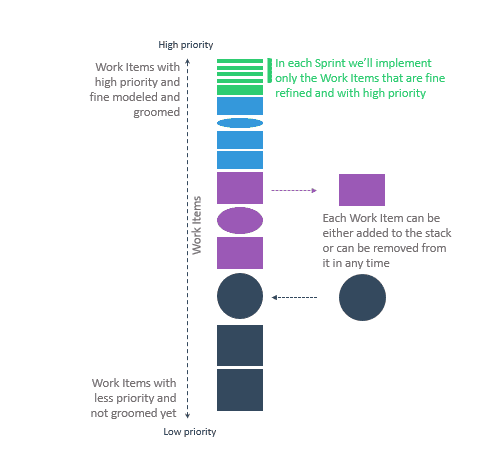Introduction
Backlog is a living part of the project or heart of the project which should be maintained properly on a regular basis. This doesn’t mean that we should refine every single work item in the backlog, but we should focus on having finely groomed work items that will be sufficient for the next two coming sprints.
As the timing to deliver work items approaches, we should be more certain that the top work items will be delivered soon. At that time, we would definitely want to understand the requirements better, with a higher level of detail on what is actually expected from the work or delivery perspective. This is a great opportunity to get inside the head of the Product Owner and ask questions to understand the requirements in detail. This will help the team deliver the expected result.
Backlog refinement through time
In the image below, you will see that at the end of the Backlog, there are work items which will probably be divided in later grooming sessions into smaller work items. During our development, we’ll be adding new work items or removing existing ones if they become obsolete. The more we approach the work items with higher priority, the more detailed and refined they will be.
This means that the work items with higher priority will capture requirements in more detail, with more meaningful titles, more detailed descriptions, and well-defined acceptance criteria. The more we go down in the backlog, the less defined and detailed the items will be. We can use different techniques like MoSCoW prioritization.
In some approaches, requirements are captured as User Stories, which explain what is expected from the user’s perspective. If you wish to read more details about user stories, I welcome you to read this post about User Stories.
There are many benefits from capturing requirements as User Stories, one of which is the ability to define requirements from a perspective that will bring value to the end user. Refining the requirements has significant meaning for delivering a working piece of product or service. This refinement is usually done in stages when the development of these items is getting closer to the actual beginning of the work or development. In Scrum, we usually use some successful techniques for defining the requirement’s size and content. I will explain more about requirements size and estimations in my next post.
[More Info]{.ion-info} The post User stories in Agile world focuses on an important unit of the Agile software development process, which is the User Story. The post also describes some basic rules and recommendations you have to follow before adding the descriptions of PBI.
Key tips for maintaining a good backlog
Every team will choose the right fit for them in order to keep the Backlog in vital condition. But there are still some main points that every team should take into consideration to keep the backlog ready and well maintained.
Some featured or key tips on how to keep the backlog vital:
- Always be ready for the next two weeks, have all the work items for the following two weeks prioritized and finely refined or groomed.
- Prioritize work items in the backlog wisely and include only high-level requirements at the top of the backlog.
- Use an appropriate level of detail, meaning that all the user stories which will be developed soon need to be well understood by all team members so that they can be completed in the coming sprint.
- Regular Maintenance of the Backlog
Conclusion
Keeping the Backlog in a good state is not only important for capturing the requirements but also for the team’s understanding of requirements. Backlog Refinement will help teams to understand the requirements better and gain better visibility.
[More Info]{.ion-info} In order to ensure Continuous Integration, we need to use a proper deploying strategy. Read more about deploying with Feature Branches and Feature Toggle in the following post: Deploy from Branches with and without Feature Toggle.


